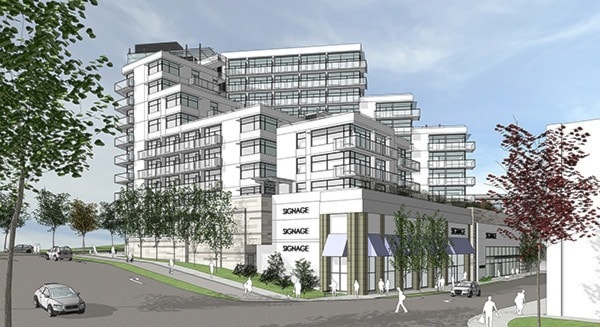Plans for what will be the tallest building in Saanich promise to improve the local supply of affordable housing, but a local community leader is not so sure in calling for a “broader conversation” about the affordability of housing in Saanich.
Council last week approved the fourth and final phase of the so-called Uptown development following a public hearing.
This approval paves the way for the construction of a 14-storey building at the southeast corner of Carey Way and Ravine Way that would include 134 rental units, more than 5,000 square-metres of retail space and additional parking.
Sixty per cent of the approved units spread across 127 apartments and seven townhouses would be affordable for a working couple earning about $15 per hour each, according to documents submitted by applicant Morguard Investments Limited on behalf of the pension fund that owns Uptown.
The approved development will “significantly” increase the supply of purpose-built rental homes in Saanich, according to a Saanich staff report.
But Carol Hamill of the Mount View Colquitz Community Association (MVCCA) questioned this claim in an interview.
While her organization is “very supportive” of any project that increases the number of rental units in Saanich, she does not believe that this particular project will add more units, in echoing points that she made in a letter to council on behalf of the community association.
“I just want to be clear that although we welcome the construction of rental units, the net gain of rental space is limited,” she wrote. “The conventional wisdom is that older units will become available as a result of new rental units, (but) that principle does not apply to ‘high-end renters.’” Saanich renters, in other words, will “‘not move up’” to the new rental units, because the project advertises itself to high-end renters. “As a result, very few existing rental units will be vacated,” she wrote.
She also noted that the “people who work in the Uptown mall will not be able to afford to rent in the Uptown housing. It is difficult to imagine how any highrise tower can be both a beautiful design and also affordable to rent.”
Coun. Colin Plant said in an interview that the fourth phase of the Uptown development will be a “positive” for Saanich, because like the rest of the Greater Victoria area, rental housing “is not something that we have an excess of.”
But Plant also qualified his praise for the project in acknowledging some of the concerns Hamill raised.
“I am satisfied to a degree (about the project), but I would have liked to have seen units in the building that would have been available to people making less than $30 an hour as a couple,” he said in promising to push for policies to improve the stock of affordable housing.
Saanich, unlike other communities, currently lacks a policy that asks developers of multi-unit developments to set aside specific amounts of affordable housing as a condition of development approval.
“It [affordable housing] was something that we have to ask for,” said Plant.
What Plant describes appears in the literature as inclusionary zoning. It has become increasingly popular across Canada as communities try to address affordable housing shortages, but also faces opposition from developers, who fear that it will add layers of fees and bureaucracy, according to a 2009 report by the Canadian Policy Research Networks.
Council’s approval of the rental units comes during ongoing concerns about the availability and affordability of housing in Saanich and across Greater Victoria.
The latest available Canada Mortgage and Housing Corporation figures dated October 2015 peg the regional vacancy rates at 0.6 per cent, the lowest in the country.
Average rental rates also rank among the highest and a Victoria Foundation report released last month finds almost two-thirds of available housing in Greater Victoria is unaffordable for most of its residents.
Various reports, however, also note that the construction of new rental units has risen across the region in recent months and the new rental units at Uptown fit this pattern as demand for such housing has surged.
It should be noted that the construction of rental units was not the applicant’s first choice.
Initial site plans called for construction of condominiums, plans put on hold as the demand for such units declined in the wake of the Great Recession.
Coun. Dean Murdock referenced this history earlier this summer when council first considered the proposed rental building.
“Uptown has been a work in progress for nearly a decade and the residential was the most exciting part yet to come,” he said. “The world has changed a lot from 2007 when Morguard talked about putting condos in this location. If the condos had happened, we would actually have more housing, but we wouldn’t have had rental, so this a big bonus, it’s a boost.”
The approved building itself consists out of two components: a three-storey podium that would house the commercial space and the residential building consisting out of two wings that create a U-shape. The south wing of the building would terrace up from three to nine storeys while the north wing would terrace up from five to 11 storeys.
Geoff Nagle, Morguard’s director of development for Western Canada, welcomed council’s approval. On behalf of the Uptown owners, Morguard “is very excited to begin the next steps in the continuing evolution of the emerging urban core of Saanich,” he said in an email.
If all goes as planned, Morguard will have completed the design development, lease negotiations, construction documentation, building permit and tendering processes as early as summer 2017, Nagle said.
Construction could start then, he said, adding current plans allow 26 to 30 months for construction.
As of this writing, B.C. Assessment values the Uptown development at about $300 million.
